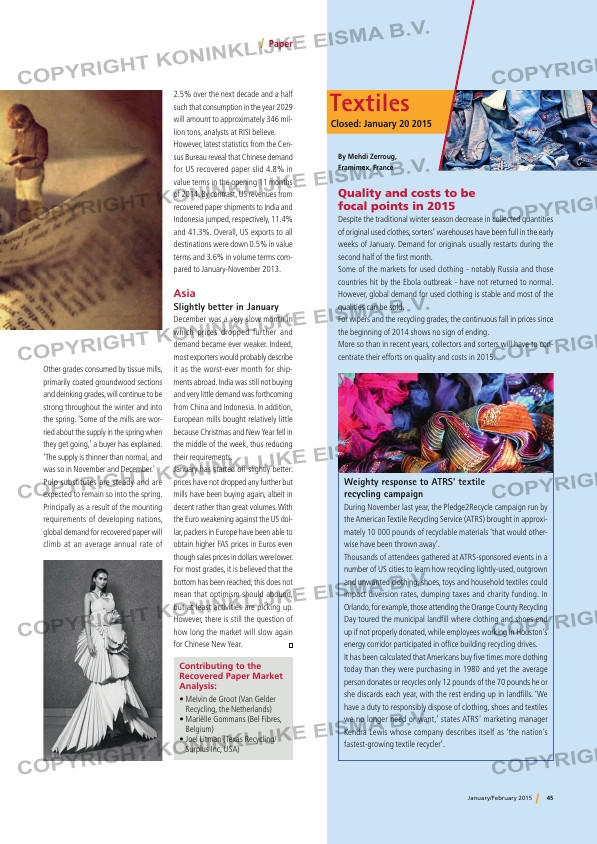Page 45 from: January / February 2015

Paper
Textiles
Closed: January 20 2015
45January/February 2015
Other grades consumed by tissue mills,
primarily coated groundwood sections
and deinking grades, will continue to be
strong throughout the winter and into
the spring. ‘Some of the mills are wor-
ried about the supply in the spring when
they get going,’ a buyer has explained.
‘The supply is thinner than normal, and
was so in November and December.’
Pulp substitutes are steady and are
expected to remain so into the spring.
Principally as a result of the mounting
requirements of developing nations,
global demand for recovered paper will
climb at an average annual rate of
By Mehdi Zerroug,
Framimex, France
Quality and costs to be
focal points in 2015
Despite the traditional winter season decrease in collected quantities
of original used clothes, sorters’ warehouses have been full in the early
weeks of January. Demand for originals usually restarts during the
second half of the first month.
Some of the markets for used clothing – notably Russia and those
countries hit by the Ebola outbreak – have not returned to normal.
However, global demand for used clothing is stable and most of the
qualities can be sold.
For wipers and the recycling grades, the continuous fall in prices since
the beginning of 2014 shows no sign of ending.
More so than in recent years, collectors and sorters will have to con-
centrate their efforts on quality and costs in 2015.
Weighty response to ATRS’ textile
recycling campaign
During November last year, the Pledge2Recycle campaign run by
the American Textile Recycling Service (ATRS) brought in approxi-
mately 10 000 pounds of recyclable materials ‘that would other-
wise have been thrown away’.
Thousands of attendees gathered at ATRS-sponsored events in a
number of US cities to learn how recycling lightly-used, outgrown
and unwanted clothing, shoes, toys and household textiles could
impact diversion rates, dumping taxes and charity funding. In
Orlando, for example, those attending the Orange County Recycling
Day toured the municipal landfill where clothing and shoes end
up if not properly donated, while employees working in Houston’s
energy corridor participated in office building recycling drives.
It has been calculated that Americans buy five times more clothing
today than they were purchasing in 1980 and yet the average
person donates or recycles only 12 pounds of the 70 pounds he or
she discards each year, with the rest ending up in landfills. ‘We
have a duty to responsibly dispose of clothing, shoes and textiles
we no longer need or want,’ states ATRS’ marketing manager
Kendra Lewis whose company describes itself as ‘the nation’s
fastest-growing textile recycler’.
2.5% over the next decade and a half
such that consumption in the year 2029
will amount to approximately 346 mil-
lion tons, analysts at RISI believe.
However, latest statistics from the Cen-
sus Bureau reveal that Chinese demand
for US recovered paper slid 4.8% in
value terms in the opening 11 months
of 2014. By contrast, US revenues from
recovered paper shipments to India and
Indonesia jumped, respectively, 11.4%
and 41.3%. Overall, US exports to all
destinations were down 0.5% in value
terms and 3.6% in volume terms com-
pared to January-November 2013.
Asia
Slightly better in January
December was a very slow month in
which prices dropped further and
demand became ever weaker. Indeed,
most exporters would probably describe
it as the worst-ever month for ship-
ments abroad. India was still not buying
and very little demand was forthcoming
from China and Indonesia. In addition,
European mills bought relatively little
because Christmas and New Year fell in
the middle of the week, thus reducing
their requirements.
January has started off slightly better:
prices have not dropped any further but
mills have been buying again, albeit in
decent rather than great volumes. With
the Euro weakening against the US dol-
lar, packers in Europe have been able to
obtain higher FAS prices in Euros even
though sales prices in dollars were lower.
For most grades, it is believed that the
bottom has been reached; this does not
mean that optimism should abound,
but at least activities are picking up.
However, there is still the question of
how long the market will slow again
for Chinese New Year.
Contributing to the
Recovered Paper Market
Analysis:
• Melvin de Groot (Van Gelder
Recycling, the Netherlands)
• Mariëlle Gommans (Bel Fibres,
Belgium)
• Joel Litman (Texas Recycling/
Surplus Inc, USA)
RI1_Analysis Paper&Textiles.indd 45 21-01-15 14:20



